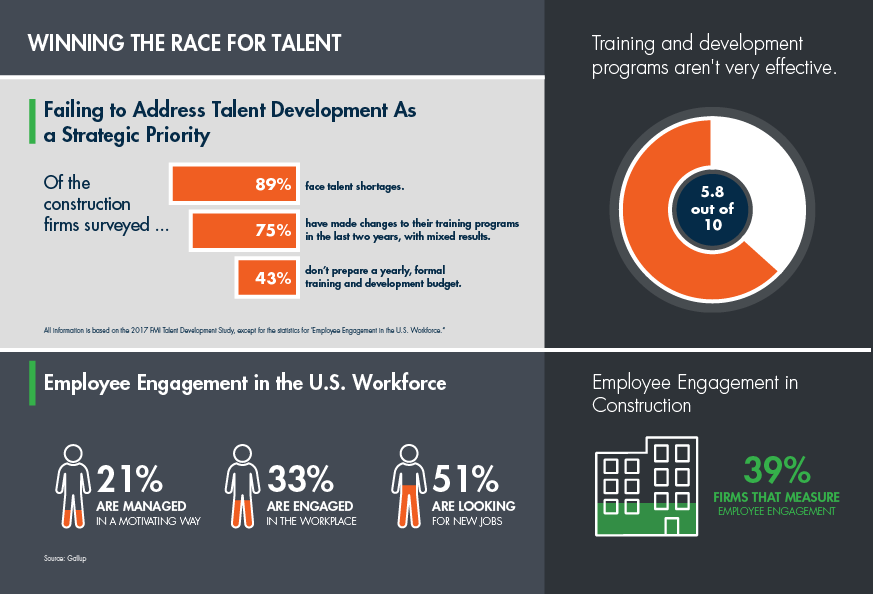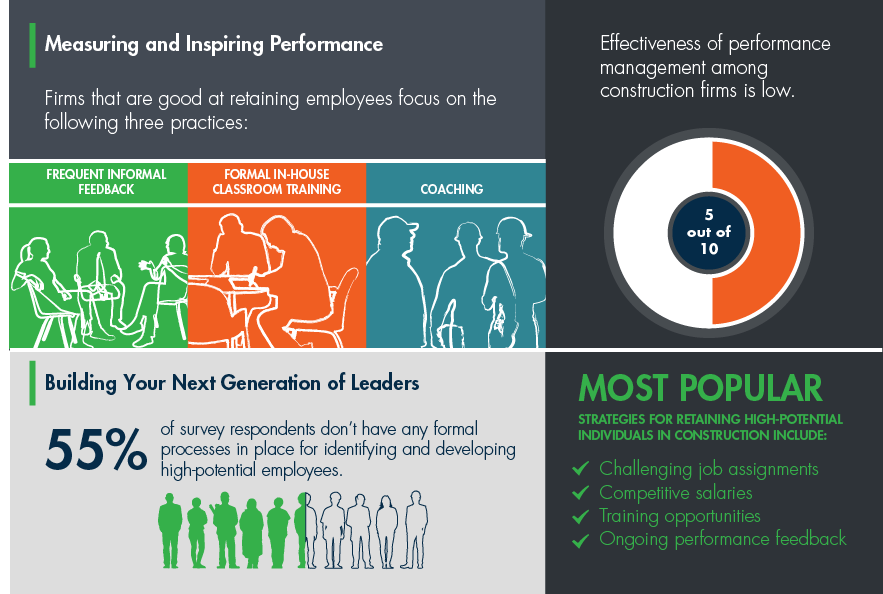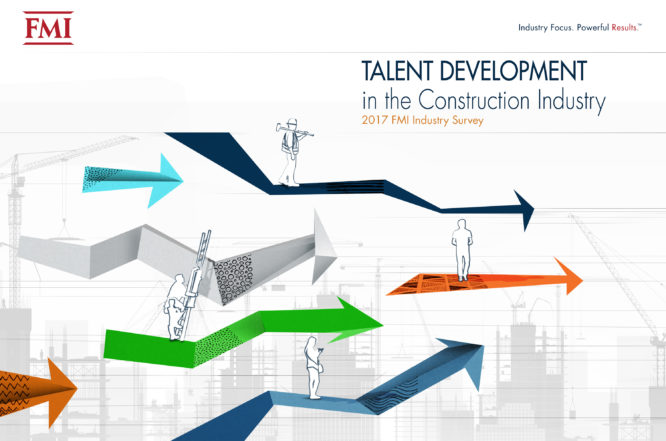Most construction firms are grappling with talent shortages right now, according to FMI’s new Talent Development Survey. Here’s what you can do about it.
The U.S. talent shortage is no laughing matter, nor is it going to be solved overnight. Findings from “FMI’s 2017 Talent Development Survey” paint a mixed picture of how construction firms are addressing people development. In many cases, the topics of human resources (HR) and talent development are still being tackled in a very tactical, piecemeal manner, at best. Leading organizations, however, recognize the need for a systematic and strategic approach and are investing in the necessary people and resources to set up long-term talent management programs.
“89% of firms surveyed are currently grappling with talent shortages” — FMI’s new Talent Development Survey
The problem is that, for the most part, construction firms are failing to address talent development as a strategic priority. For example, most lack formalized training programs or career ladders for their workforces and are wrestling with ways to change their existing programs to meet new needs.
The majority of firms surveyed (89%) are currently grappling with talent shortages; 75% have tweaked their training programs in the last two years (with mixed results); and 43% admit that they don’t prepare a yearly, formal training and development budget. And nearly 60% of companies say that their training and development programs “aren’t very effective.”
Six Ways to Turn the Tide
As the E&C industry continues to undergo a rapid digital transformation, leaders must continually assess their talent needs and adapt their talent strategies. To stand the best chances of creating a substantial inflow of new talent into the industry, they’ll need to take these six steps:
- Take stock of the organization’s current resources, including skills and competencies and readiness to take on future roles (i.e., strong succession clarity). Utilize dedicated resources to address talent issues. Don’t just rely on the overworked and under-budgeted HR department to handle everything.
- Get executives highly involved in programs that address talent shortages, gaps and potential. CEOs may not be involved in the blocking or tackling of talent initiatives, but they know the issues and understand the strategies for dealing with a talent crisis, are behind initiatives to address the issues, and communicate to their teams that addressing talent is a differentiator and strategic imperative.
- Forecast talent supply for a given role (e.g., field managers, craft labor, leadership) or in a specific market and/or geography. Then, create action plans for more effective talent recruiting and selection, and enhance existing talent through performance management, feedback, training and stronger leadership.
- Don’t compromise on talent just because of a shortage (or a high volume) of work. If it is a true talent initiative (not simply addressing skill deficiencies because everyone is too busy), hiring someone who may not be a culture fit—but who has the technical chops—is always one way to ease immediate operations concerns versus implementing a long-term talent strategy.
- Build out the leadership pipeline. Best-in-class firms focus on building internal systems and structures that ensure that their next generation of leaders is continually developing its skills. This greatly contributes to long-term employee loyalty, because high potentials who see the company investing in their long-term potential have a greater sense of commitment to their organizations.
- Invest in non-traditional learning methodologies. E&C firms rarely implement learning tools, such as formal and informal mentoring, individual coaching, clearly defined career paths or ongoing performance feedback—all of which are particularly critical for developing high potentials.
An ongoing challenge for the construction industry, the dearth of skilled talent will only become more severe in the future. Going forward, firms must redefine the role of human resources in a way that gives HR leaders a seat at the senior leadership table. Tomorrow’s successful industry leaders will be those that find ways to effectively blend the strategies, practices and processes needed to overcome people obstacles and create a sustainable competitive edge for their organizations.


By the Numbers—Key Report Findings
- 89% of companies are dealing with talent shortages.
- 75% have made changes to their training programs in the last two years, with mixed results.
- 43% reported that their firms don’t prepare a formal annual training and development budget.
- 55% of survey respondents lack any formal processes for identifying and developing high-potential employees.
- Overall, training and development programs aren’t very effective.
- Most firms struggle with performance management.
- Organizations with the highest employee retention have committed to rich professional development cultures and have effective performance management processes.
Read “FMI’s 2017 Talent Development Survey” full report here.

